Where do the Serpentine Pavilions go after the summer season?
The Serpentine Pavilions are a beloved summer staple in the annual architecture calendar, but what happens to them after their time at Kensignton Gardens is over? Here, we track their whereabouts and follow their journey around the world
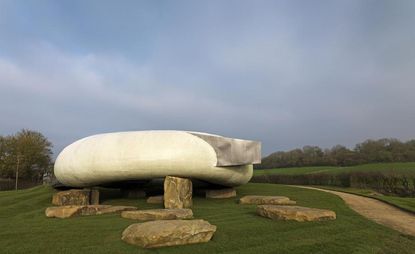
It won’t be long now before this year’s Serpentine Pavilion appears in Kensington Gardens, on the lawns outside the Serpentine Gallery. The latest edition has been designed by Sumayya Vally and her young South African practice Counterspace. The commission followed the Mexican architect Frida Escobedo (at 38 by far the youngest to take up the privilege in 2018) and Junya Ishigami in 2019.
Further predecessors, now numbering over 20, have ended up all over the world, mostly purchased by wealthy, enlightened art collectors. 2017's version by Diébédo Francis Kéré, an architect from Burkina Faso, was snapped up by the Ilham Gallery of Kuala Lumpur and is yet to be set up in its new home somewhere in the Klang Valley region where KL is located. Such cultural cross-pollination – Kere’s pavilion has a proudly African language – has become an inadvertent outcome of a project that really started out by accident.
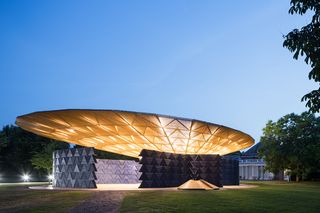
Francis Kéré’s 2017 Serpentine Pavilion.
In 2000, Julia Peyton-Jones, the gallery’s co-director from 1991 to 2016, asked her friend Zaha Hadid to design a temporary shelter for the Serpentine’s 30th birthday celebrations. The triangulated structure – a great success – stayed in place for three months and in the city which had silently decreed Hadid’s designs unbuildable at best, and unreadable at worst, became jokingly known as her first building in London.
Thereafter, a series of architects who had never been invited to construct in the capital – names as stellar as Oscar Niemeyer, Jean Nouvel and Rem Koolhaas – went on to create temporary shelters for the Serpentine’s summer season.
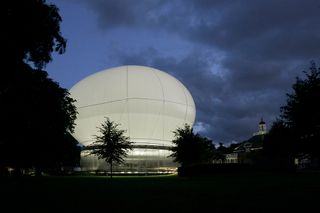
Rem Koolhaas’ 2006 Serpentine Pavilion.
Zaha’s tent met a less than illustrious end – first it spent some time in a car park in Stratford-upon-Avon and now resides at the Flambards Theme Park in Helston, Cornwall. It is covered in a silvery grey tarpaulin, and a very popular wedding venue. And the Cloud, an ethereal architectural abstraction by the Japanese Sou Fujimoto from 2103, floated off to Albania, where it controversially stood in front of Tirana’s National Gallery and was quickly co-opted by Albanian Vodaphone as a great place to hang their advertising.
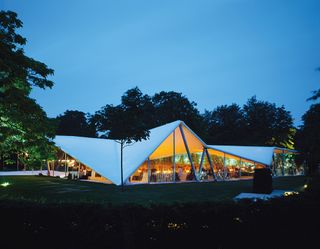
Zaha Hadid’s 2000 Serpentine Pavilion.
But others have gone on to find highly desirable homes. The one by Smiljan Radic, which stood like a radical pebble in Kensington Gardens in the summer of 2014, travelled to Bruton in Somerset. There it forms the perfect full-stop to gardens designed by plantsman Piet Oudolf at the Hauser & Wirth art campus of Durslade Farm. ‘It’s extraordinary – no, exceptional – to see a building in quite another situation. Usually it’s the building that stays in one place, and the landscape that changes around it,’ said Radic at the time of its re-installation, as though he had seen a ghost.
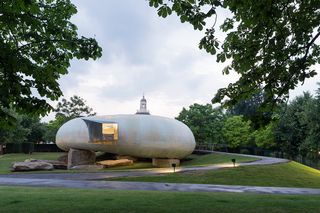
Smiljan Radic’s 2014 Serpentine Pavilion.
The property developer Victor Hwang took Toyo Ito’s 2002 geometric explosion off to the south of France, where it sits in the grounds of Le Beauvallon, a belle epoque chateau. ‘It’s a visual masterpiece,’ said Hwang of the project which is now surrounded by parasol pines, and next to the sea. Not far away, the Irish hotelier and developer Paddy McKillen has found a space for Frank Gehry’s equally explosive variant at Château La Coste, where it rubs shoulders with works by Tracey Emin, Richard Serra and Lee Ufan. ‘When Frank saw it here, he was really moved,‘ said McKillen of the dip in the landscape where its placed. ‘you can look down on it now, and get a real sense of its multiple perspectives.’ Stephen Rea liked it so much, he staged a Bloomsday celebration in honour of James Joyce there.
Wallpaper* Newsletter
Receive our daily digest of inspiration, escapism and design stories from around the world direct to your inbox.
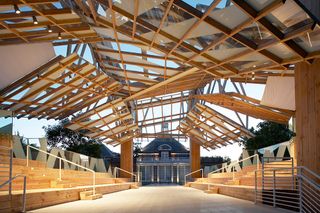
Frank Gehry’s 2008 Serpentine Pavilion.
Some remain in boxes, though not for long. The multi-coloured cellophane folly by the Catalan practice SelgasCano from 2015 will be installed in Los Angeles as soon as co-working brand Second Home has set up its space in the city. Bjarke Ingels’ modular masterpiece from 2016 is to be reassembled, block by translucent fibreglass block, in Toronto by late summer. He’s Danish and practises internationally. Anyway, who cares. Suffice to say, these pavilions are definitely proving to be architecture without borders.
INFORMATION
The Serpentine Pavilion designed by Sumayya Vally and Counterspace opens in June 2021
-
 Jaguar reveals its new graphic identity ahead of a long-awaited total brand reboot
Jaguar reveals its new graphic identity ahead of a long-awaited total brand rebootJaguar’s new ethos is Exuberant Modernism, encapsulated by a new visual language that draws on fine art, fashion and architecture
By Jonathan Bell Published
-
 Olfactory Art Keller: the New York gallery exhibiting the smell of vintage perfume, blossoming lilacs and last night’s shame
Olfactory Art Keller: the New York gallery exhibiting the smell of vintage perfume, blossoming lilacs and last night’s shameOlfactory Art Keller is a Manhattan-based gallery space dedicated to exhibiting scent as art. Founder Dr Andreas Keller speaks with Lara Johnson-Wheeler about the project, which doesn’t shy away from the ‘unpleasant’
By Lara Johnson-Wheeler Published
-
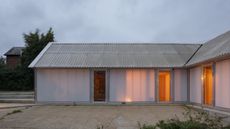 Explore a barn conversion with a difference on the Isle of Wight
Explore a barn conversion with a difference on the Isle of WightGianni Botsford Architects' barn conversion transforms two old farm buildings into an atmospheric residence and artistic retreat, The Old Byre
By Jonathan Bell Published
-
 Meet Kenia Almaraz Murillo, the artist rethinking weaving
Meet Kenia Almaraz Murillo, the artist rethinking weavingKenia Almaraz Murillo draws on the new and the traditional in her exhibition 'Andean Cosmovision' at London's Waddington Custot
By Hannah Silver Published
-
 Inside Jack Whitten’s contribution to American contemporary art
Inside Jack Whitten’s contribution to American contemporary artAs Jack Whitten exhibition ‘Speedchaser’ opens at Hauser & Wirth, London, and before a major retrospective at MoMA opens next year, we explore the American artist's impact
By Finn Blythe Published
-
 Doc'n Roll Film Festival makes its loud return to the UK
Doc'n Roll Film Festival makes its loud return to the UKThe 11th edition of the Doc'n Roll Film Festival celebrates music, culture and cinema from around the world
By Smilian Cibic Published
-
 Preview the Jameel Prize exhibition, coming to London's V&A, with a focus on moving image and digital media
Preview the Jameel Prize exhibition, coming to London's V&A, with a focus on moving image and digital mediaThe winner of the V&A and Art Jameel’s seventh international award for contemporary art and design inspired by Islamic tradition will be showcased alongside shortlisted artists
By Smilian Cibic Published
-
 Genesis Belanger is seduced by the real and the fake in London
Genesis Belanger is seduced by the real and the fake in LondonSculptor Genesis Belanger’s solo show, ‘In the Right Conditions We Are Indistinguishable’, is open at Pace, London
By Emily Steer Published
-
 Francis Bacon at the National Portrait Gallery is an emotional tour de force
Francis Bacon at the National Portrait Gallery is an emotional tour de force‘Francis Bacon: Human Presence’ at the National Portrait Gallery in London puts the spotlight on Bacon's portraiture
By Hannah Silver Published
-
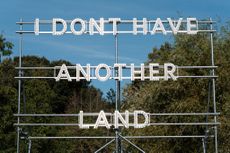 Frieze Sculpture takes over Regent’s Park
Frieze Sculpture takes over Regent’s ParkTwenty-two international artists turn the English gardens into a dream-like landscape and remind us of our inextricable connection to the natural world
By Smilian Cibic Published
-
 Meet Oluwole Omofemi and Bayo Akande, the founders creating a new art community
Meet Oluwole Omofemi and Bayo Akande, the founders creating a new art communityOluwole Omofemi and Bayo Akande, are behind Piece Unique, an artist agency that guides and future-proofs emerging artists’ careers
By Mazzi Odu Published